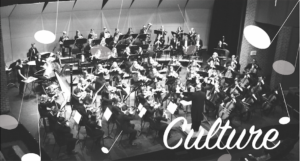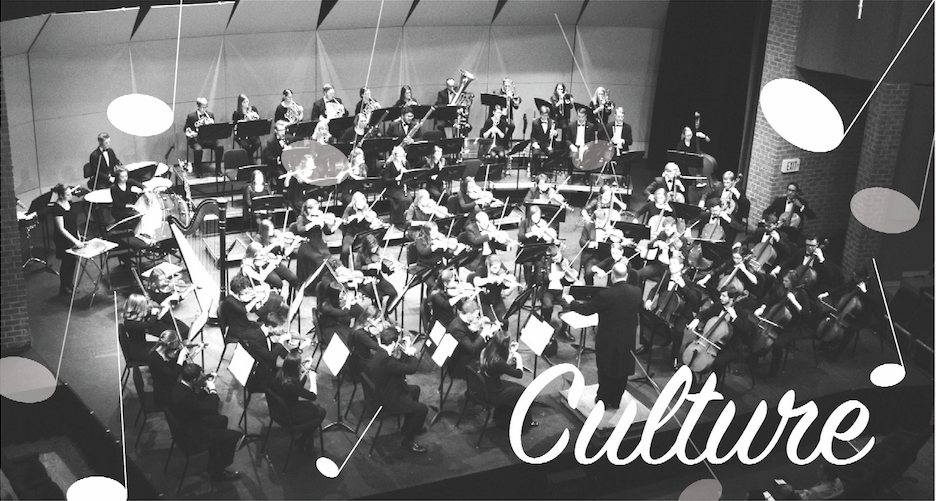
Of all the possible reasons to overhaul an orchestral program for the semester,
being selected to perform at a national conference is one of the best.
The college orchestra was selected to perform at the College Orchestra Directors Association’s annual conference at George Mason University this Feb. 2 through 4, one of only two orchestras featured from more than 300 member schools. The selection, made from a blind audition of concert recordings from the last two years, marks the first time the Hillsdale College orchestra will perform on a national stage.
“I’m thrilled,” Orchestra Director James Holleman said. “For me, this is the perfect group of students that I would like to take to something like this. This orchestra has really reached a peak this year with balance between the strings, woodwinds, brass, and percussion. I feel that we’re at one of our strongest points in the past 20-year growth of this program.”
The 79-member orchestra will travel to Washington, D.C., for a Friday performance of their own work, as well as attending master class sessions and a performance by the National Symphony Orchestra in the Kennedy Center.
“You couldn’t ask for a better way to go out, as a senior getting to play in D.C. with my friends,” senior violinist Stevan Lukich said. “That’s what I’m really looking forward to, is getting to experience this with the friends I’ve played with in the last four years. This is a really cool thing for the orchestra to be able to do.”
Hosted by CODA, an organization founded in 2002 to connect college orchestra directors throughout the world, the conference has been a way for college-age musicians and their directors to perform together and learn from each other. With member orchestras from the United States, Europe, South America, and Australia, CODA is the world’s largest association for collegiate orchestra directors, said CODA president Kevin Bartram.
Their annual conference often features orchestras much larger than Hillsdale’s, Bartram said: “Many of the groups who submitted recordings include large institutions and some from Europe. It is uncommon to accept an orchestra from a school the size of Hillsdale, as only two orchestras perform each year.”
Though their performance will be the highest priority, Holleman said, the conference will also allow Hillsdale students to meet and rehearse with members of the University of Tulsa Symphony Orchestra (the other orchestra selected to perform) in master class sessions for conducting students from George Mason, the hosting university.
Hillsdale was not originally selected to perform in the conference, but when financial issues forced another music program to give up their spot at the conference late in August, Hillsdale was next on the list.
And though the orchestra had already begun rehearsing an entirely different program for the fall semester, Holleman knew it was time to start again from the top, preparing a new 60 minutes of music for a national stage, in addition to their normal performance cycle, which included local concerts and a performance of Handel’s “Messiah” at the end of the semester.
Holleman said he wanted to select repertoire that would both highlight the orchestra’s strengths and introduce other college music directors to unique, yet approachable music.
“I wanted to put our best foot forward to focus on our strengths as an orchestra,” Holleman said. “But I also wanted to be somewhat educational in my approach, knowing that our primary audience is college orchestra directors from around the country.”
The planned repertoire is a mix of pieces from performances over the last two years, including Giuseppe Verdi’s “Overture to Sicilian Vespers,” Ralph Vaughan Williams’ “Serenade to Music,” Leonard Bernstein’s “Overture to Candide,” and Benjamin Britten’s “Four Sea Interludes from Peter Grimes,” and the fourth movement of Max Bruch’s “Scottish Fantasy.”
As a featured soloist, Lukich also influenced the music selection, encouraging Holleman to perform the “Scottish Fantasy,” a piece the orchestra performed two years ago.
“I pushed this piece because it’s one of my favorites and I thought the orchestra sounded great on it two years ago,” Lukich said. “It’s a very beautiful piece. It’s melancholic, it’s joyful. It has a whole spectrum of musical spectrum of emotions and colors of sound. You do get this sense of it being inspired by Celtic music without getting hit over the top of the head with it. It’s not like a jig, but you can get the lilting feel of the music.”
Returning to music from past performances will allow the orchestra to polish their musicianship on pieces that many students have already enjoyed performing, Holleman said.
“I thought it would be interesting to see what we can do with music that we have already performed, have digested, have come back to, and have tried to fine-tune at a higher level because of its familiarity, and to take advantage of the rehearsal time that we do have,” Holleman said.
Since the orchestra has focused primarily on their local performances and Handel’s “Messiah” this semester, this familiarity with the music will be important when they return to the pieces next semester. With only two weeks of class before performances, Holleman plans to have orchestra students return early from winter break for two full days of rehearsal.
Freshman harpist Colleen Trainor began rehearsing with the orchestra the week after the “Messiah” performance. The music isn’t easy, she said, and Lukich’s “Scottish Fantasy” selection is a special challenge.
“The Bruch is a bit of a monster,” Trainor said. “But I think I can handle it.”
Of the four pieces that feature harp, Trainor is new to all but the Vaughan Williams “Serenade to Music,” which the orchestra performed in their October concert.
Despite this limited time to prepare for their first national performance, Holleman said he trusts his orchestra’s talent and experience.
“We’ve already started at a higher level, but we haven’t had a lot of time because of our rehearsal schedule,” Holleman said. “I’m confident that with the amount of time we have before next semester, we will be well prepared.”
This leadership stems from a string and brass section filled with upperclassmen: “One of the primary strengths of the orchestra are our five senior first violinists. They were one of the strongest freshman violin classes we’ve had over the years. They’ve shown real leadership, and first violin really carries the repertoire. We also have many senior principal players in the woodwinds and in the brass,” Holleman said.
But he has just as much confidence in the younger musicians; he said he planned a program that was heavier on harp knowing that Trainor is a “very accomplished” harpist.
“This is challenging repertoire compared to what I expected in playing with an orchestra, but I’m excited,” Trainor said. “It has really pushed me to see so many people devoted to music.”
Lukich agreed that the support and expertise of his fellow musicians will bring the program together.
“It’s been really neat to see us grow in the last four years,” Lukich said. “I’ve seen people really raising the bar in the last year or two in being prepared for rehearsals. That way, Professor Holleman doesn’t have to be worried about fixing problems. He can focus on the musical ideas.”
Holleman said he is planning a concert in late January to give the orchestra a chance to rehearse in front of a live audience before they take the stage in Washington, D.C.
“We’ve claimed for years that with a school our size, we have a very unique, quality orchestra,” Holleman said. “Now we get to perform on a national stage, and have some of that verified.”
But for Lukich, the audience is less important than the music itself: “I’ve never done something like playing with an orchestra in a place like Washington, D.C., before, so in the sense of it being a new place and a different, high-caliber kind of crowd, that’s a new experience for me. But at some point in being a violinist I found out that the way to deal with nerves is turning it into excitement. Before every performance I think that what really matters is telling the story of the music. That’s what gets me through. And when I approach a performance that way, it doesn’t matter who the audience is.”

